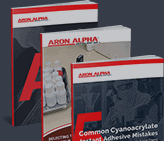Types of Medical Device Adhesives and Their Applications
Throughout the years, innovations in construction material and manufacturing processes have led to medical-grade adhesives replacing the use of traditional fastening systems in medical device assemblies. When properly applied, adhesives present significant advantages over other mechanical fastening methods.
Adhesives are available in a variety of forms—including structural, non-structural, spray, and pressure sensitive—to suit different attachment and assembly applications in the medical industry. The following blog post focuses on the differences between these forms, outlining their characteristics, product examples, and best use cases.
Structural Adhesives
Structural adhesives are primarily characterized by their outstanding load bearing capabilities. These chemically curing compounds are available in one-part or two-part epoxies, acrylics, or urethanes and generally demonstrate high strengths and excellent adhesive properties for a variety of substrate materials. They are suitable for use in attachment and assembly operations involving metal, plastic, rubber, and other difficult to bond materials without surface preparation.
Structural adhesives find use in a broad range of medical device applications—including bonding surgical instruments and equipment, affixing plastic soles to the bottom of cast boots, and attaching rubber bumpers on the bottom of crutches, canes and walkers—as replacements for more traditional fastening systems, such as nails, screws, and rivets.
There are a variety of structural adhesives available, cyanoacrylates being one of the most widely used in the medical device industry.
Cyanoacrylates
Cyanoacrylates—also known as instant adhesives—are solvent-free and fast curing adhesives that create thin film bonds between attached surfaces. These one-part liquid compounds rapidly cure—i.e., harden—when exposed to moisture, creating rigid, thermoplastic bonds with superior adherence to a broad range of substrates. Different formula variations also accommodate accelerated curing with the addition of UV or visible light.
Cyanoacrylates have replaced traditional solvents in the manufacture of IV tube sets, needle bonding, attaching plastic tubing to a blood bag, and a variety of other medical applications that require durable and dependable bonds.
Non-structural Adhesives
Non-structural adhesives commonly find application in non-critical assemblies or assemblies that do not bear excessive loads or require flexibility after the formation of the adhesive bond. In contrast to structural adhesives, these compounds do not cure chemically, instead creating a physical attachment.
Some examples of non-structural adhesives include hot melts, contacts, aerosols (i.e., sprays), and rubber and gasket adhesives. These adhesive compounds form adhesive bonds in a variety of ways, including by solidifying and bonding as they cool (e.g., hot melts) or bonding as they dry (e.g., solvent-based/water-based contact adhesives). Rubber, plastic, fabric, foam, leather, metal, and glass are common materials bonded by non-structural adhesives.
Spray and Hot Melt Adhesives
Spray and hot melt adhesives see limited use in sensitive medical equipment assembly applications. They generally find use in bonding foam to foam (or case material), fabric to wood, or plastic to metal in the assembly of equipment cases and wheelchair seat cushions, allowing manufacturers to eliminate the need for stitching or riveting.
Pressure Sensitive Adhesives
Pressure sensitive adhesives (PSAs) are widely used in medical device assembly applications. As their name suggests, these adhesive compounds require sufficient pressure to form an adequate mechanical bond. This unique application and bonding method is largely due to the compounds’ viscoelastic properties, which allow them to flow into the bonding surface while resisting stress due to elasticity.
Applications that use PSAs tend to involve non-uniform surfaces, which require adhesives to flow into the nooks and crannies of the substrate. Other common applications include the manufacture of blood glucose monitoring strips and attachment of products to the skin, such as surgical drapes, insulin pumps, and first aid or wound dressing.
Contact Aron Alpha Today
Selecting the right adhesive for a medical device assembly application requires careful consideration of the types available, their characteristics, and their best use cases. Each form of adhesive—whether structural, non-structural, or pressure sensitive—offers specific adhesive properties that make them suitable for use in a specific bonding application. In particular, advancements in cyanoacrylate adhesives have made them an excellent, solvent-free structural adhesive prized for their fast curing and durable, structural bonding properties.
To learn more about the variety of medical device adhesive solutions available, or about any of our adhesive capabilities and services, contact the experts at Aron Alpha today.





